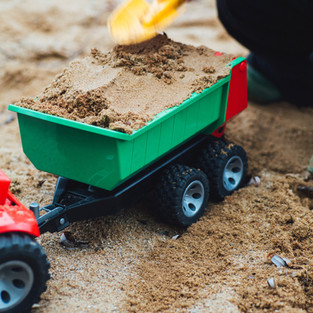THE BENEFITS OF SAND PLAY
- Sally Hills-Davis

- Mar 15, 2021
- 2 min read
Updated: Oct 24, 2024
WRITTEN BY SALLY HILLS-DAVIS.
CHILDRENS OCCUPATIONAL THERAPIST AND KIRSTY BROCKLEHURST, CHILDRENS PHYSIOTHERAPIST.
Here at the Baby, Play and Development, we feel very privileged to not only live near the sea but also have amazing sandy beaches near us too. Amazingly though, there are still children in our town that have never been to the beach!
The benefits of playing with sand have long been acknowledged. Jenny Barber wrote in the Practical Professional Child Care Journal that ‘sand does not have to be presented in a large sand tray with brightly coloured plastic resources. It has so much more to offer and can be presented in a variety of formats. Take the lead from children and encourage them to develop their ideas by responding to their interests and spontaneity’. This is so true; you do not have to be on the beach, or for that matter even have a garden to enjoy sand. You can get dry or wet sand and have it within a tray. Your child can write or draw in the sand with their fingers, have toys to drive through it, or fill small containers with it. If you are lucky enough to have a sand pit in the garden, then cups and spoons can be as much fun as a bucket and spade.
At the beach, the experience can be very different, as you have the room and copious amounts of sand around you. From a sensory perspective, the beach has a whole array of experiences. The smell of the sea and maybe seaweed. The sounds of the sea, people and seagulls. You can even taste the beach at times with sand getting everywhere and the taste of salt. The view of the crashing waves, children playing and swimming in the sea. Lastly, touch; the feel of the sand, wet, dry, course and fine sand, all have very different textures. It is no wonder that the beach can be such an eventful encounter. You can see why some children get overwhelmed at the beach!
The experience of playing in sand can, from a gross motor skill perspective, work on balance, stability and increased strength. It is great for developing muscles, with activities such as digging, building, jumping, kicking down sand castles and running on the beach. For the fine motor perspective, building, squeezing, patting, digging, using tools such as buckets and spades, all help to develop upper body strength, hand grasps, hand and arm muscles.
A lot of children may find sand and the feel of it overwhelming. If they do, you can start by putting wet sand in one zipper bag, dry sand in another. Let your child play by writing on it or having it underhand, so that they can feel the different composition of them both. Slowly, bring some sand out and draw shapes with a stick and then drive cars or walk toys through it.
References;
Barber,J (2012) ‘Playing with Sand’ Practical Professional Child’ 3, No.2 The Care Environment https://doi.org/10.12968/ppcc.2006.3.2.39026











Comments